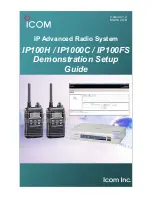
x4820 Low Pass (Tau) Filter. Set to zero (0) to turn off the tau filter. Set to 1 (weakest filter) through 6 (strongest filter) to turn on the tau
filter. (In the DX80 products, the Low Pass Filter is a combination of the median filter and the tau filter.) Write the following values to
select a low pass (tau) filter.
Low Pass (Tau) Filter
Register Value
Low Pass (Tau) Filter
Register Value
T0
0
T4
4
T1
1
T5
5
T2
2
T6
6
T3
3
46050s Battery Monitoring Parameters
Use the battery monitor parameters to monitor and set a threshold based on the incoming device voltage (on some models). The incom-
ing voltage is approximately 3.6V dc from a battery input or 4.2V dc from the 10 to 30V dc input. These parameters allow users to deter-
mine which power source is powering the MultiHop device.
6051 Enable Battery Read. Set to zero to disable the battery read function. Set to 1 to enable the battery read function.
6052 Battery Read Sample Interval. Use this parameter to set the time interval at which the incoming voltage is read. Sample Interval
(in seconds) = 0.040 seconds × 2^RegValue. Default register value: 9 (20 seconds).
6053 Battery Voltage Threshold. Use this parameter to define the incoming voltage threshold at which register 4061 will be set to a
zero or one. Set this value in number of 100mA increments. The default value is 38 (or 3.8V).
6054 Hardware Reference Select. Use this parameter to allow for the correct calibration reference for different hardware platforms. Set
to zero for 3.0V PCB Vcc. Set to one for 3.3V PCB Vcc. Default value is zero.
6061 Battery Threshold Reading. When zero (0), the incoming voltage is below the threshold defined by parameter 6053 (powered by
battery). When one (1), the incoming voltage reading is above the defined threshold (powered by a solar panel or 10 to 30V dc).
6062 Battery Voltage Reading. Actual incoming voltage reading in units of 100mV.
51000s SDI-12 Parameter Descriptions
The following characteristics are configurable for the SDI-12 devices. Device A refers to the first SDI-12 device and device B refers to the
second SDI-12 device. We are using A and B instead of numbers to avoid confusion with the actual assigned device IDs of the SDI-12
devices.
11001 SDI-12 Device Address for Device A. Assign the SDI-12 device address for the first SDI-12 device to register 11001.
11201 SDI-12 Device Address for Device B. Assign the SDI-12 device address for the second SDI-12 device to register 11201.
An SDI-12 Device Address may be an alphanumeric value of 0 through 9, ‘a’ through ‘z,’ or ‘A’ through ‘Z.’ For this reason, store its ASCII
value in the Device Address register. For example, an SDI-12 address of 0 is stored as its ASCII value of 0x30.
11002 SDI-12 Mode Select for Device A. By default, the code supports the M! command. Enter a one (1) to support the C! command.
11202 SDI-12 Mode Select for Device B. By default, the code supports the M! command. Enter a one (1) to support the C! command.
Configuration Registers for SDI-12 Devices
There are nine registers for each SDI-12 device. The parameters are used to configure the properties of the information coming back
from the SDI-12 device.
Parameter numbering for the first SDI-12 device (device A) begins at 11011, with each Modbus register number offset from the previous
one by 20 Modbus registers. For example, the first parameter for the first SDI-12 register begins at Modbus register 11011. The first
parameter for the second SDI-12 register begins at Modbus register 11021.
Parameter numbering for the second SDI-12 device (device B) begins at 11211. The registers for the second SDI-12 device are offset
from the first device by 200.
MultiHop Radio Product Manual
151317 Rev 0
www.bannerengineering.com - tel: 763-544-3164
33
















































